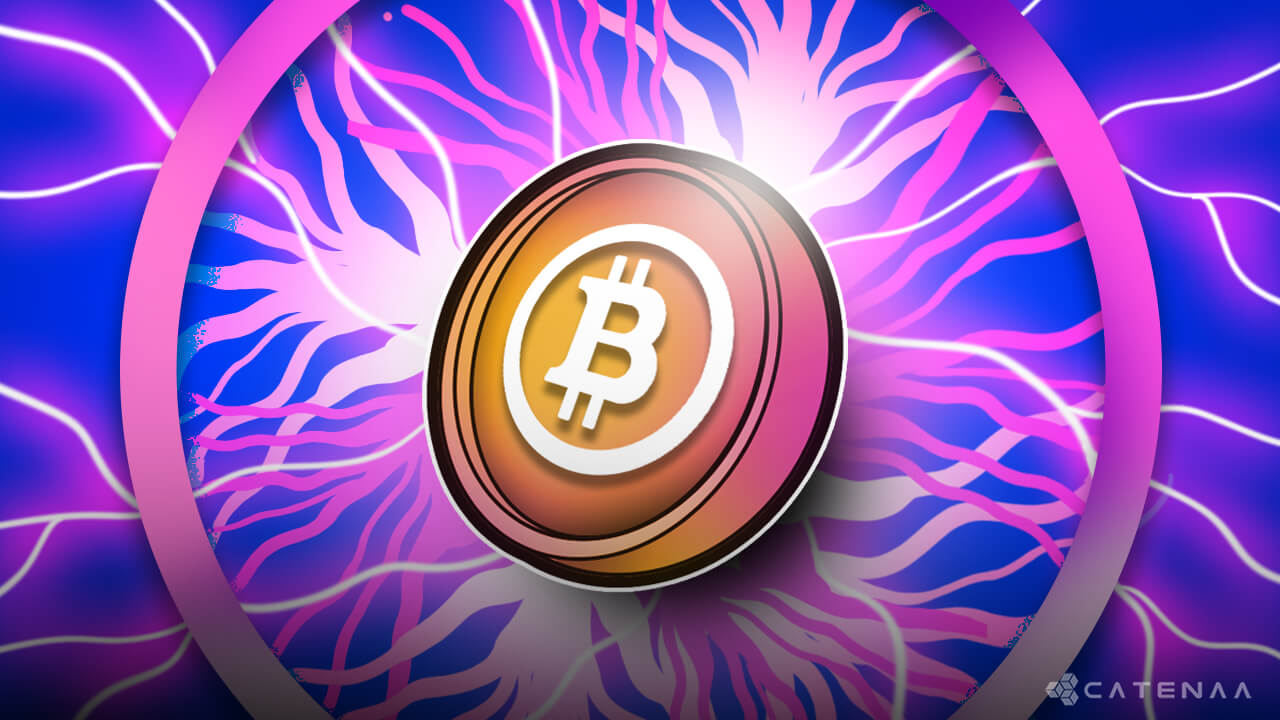Table of Content
Revolutionary developments have characterized the development of the internet, and the emergence of Web 3.0 set to further transform the online environment. The Web 3 nodes, the core pieces of a decentralized Internet environment, are at the center of this transition. These nodes, often referred to as decentralized nodes, are crucial in determining how we will connect, do business, and store data online in the future.
As part of a peer-to-peer network, these nodes allow for direct communication and direct data transfer without the use of middlemen. Validation and consensus, data storage and retrieval, and smart contract execution are just a few of the important tasks they carry out. Web 3 nodes contribute to network security and transaction integrity by taking part in consensus and validation methods. They also maintain redundancy and robustness by storing and dispersing data throughout the decentralized network. Smart contracts are also carried out via Web 3 nodes, enabling automatic and open agreements. Node operators are frequently motivated by incentives and prizes, which encourage involvement and resource commitment.
Understanding the Various Types in the Decentralised Web
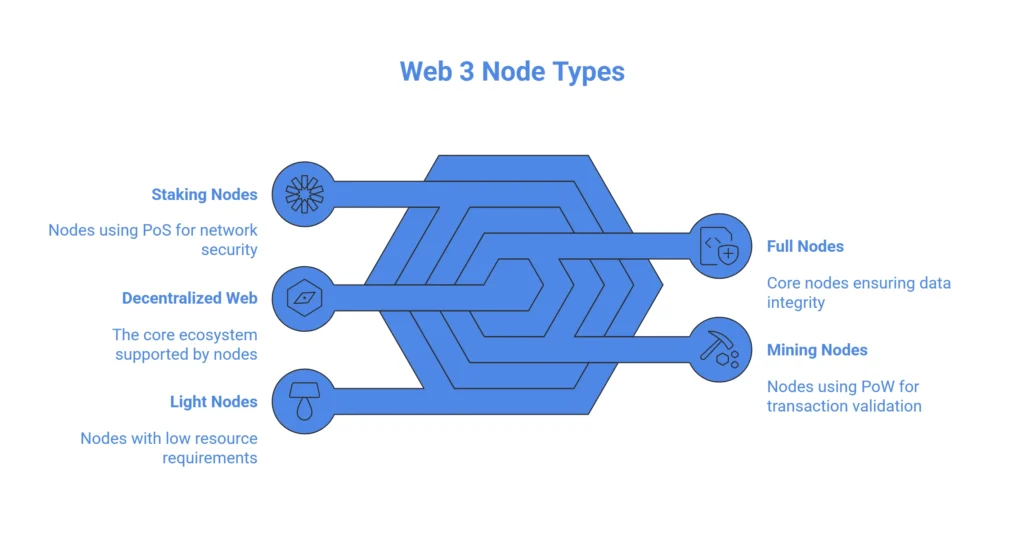
Different kinds of nodes serve different functions inside the network and contribute to the decentralized infrastructure of the Web 3 ecosystem. Here are a few of the most common Web 3 node types:
- Full Nodes: The core of the Web 3 network is made up of full nodes. They keep an exact duplicate of the distributed ledger or blockchain, verify transactions, and take part in the consensus process. Data availability and integrity are guaranteed by full nodes, which store and disseminate data throughout the network.
- Mining Nodes: Blockchain networks that employ proof-of-work (PoW) consensus procedures only utilize mining nodes. These nodes conduct mining, a computationally demanding process that entails resolving challenging mathematical puzzles to approve transactions and add new blocks to the blockchain. Mining nodes compete for rewards in the form of cryptocurrency tokens by contributing computing power.
- Master Nodes: Masternodes are nodes that give the network more functionality. They often have a stake in the health of the network and demand that a certain minimum amount of cryptocurrency tokens be retained as collateral. Masternodes can do out functions, including allowing quick transactions, taking part in governance discussions, or offering improved privacy features.
- Staking Nodes: Blockchain networks that use proof-of-stake (PoS) consensus techniques are known as staking nodes. To sustain the network’s functioning, staking entails keeping a specific number of cryptocurrency tokens in a wallet and “staking” them there as security. Staking nodes receive staking incentives to validate transactions and protect the network.
- Light Nodes: Light nodes, also known as lightweight nodes or thin clients, do not keep a complete copy of the blockchain. Instead, they rely on complete nodes to access and validate blockchain data. Light nodes have low resource needs and may be deployed on devices with limited computational power or storage space, such as mobile phones or IoT devices.
- Storage Nodes: Storage nodes are nodes that donate storage capacity and provide data hosting services in decentralized storage networks. These nodes aid in distributing and maintaining data throughout a network of participants, hence assuring redundancy and fault tolerance.
- Gateway Nodes: Gateway nodes operate as bridges between distinct blockchain networks or between a blockchain network and the regular internet. They provide interoperability and cross-chain communication by facilitating the movement of data, assets, or information across multiple systems. 1
It should be noted that the particular forms and nomenclature of Web 3 nodes may differ based on the blockchain or decentralized platform being utilized. The examples above are popular categories, but there may be variants and new types developing as the Web 3 ecosystem evolves.
Understanding the Contributions of Web 3.0 Nodes
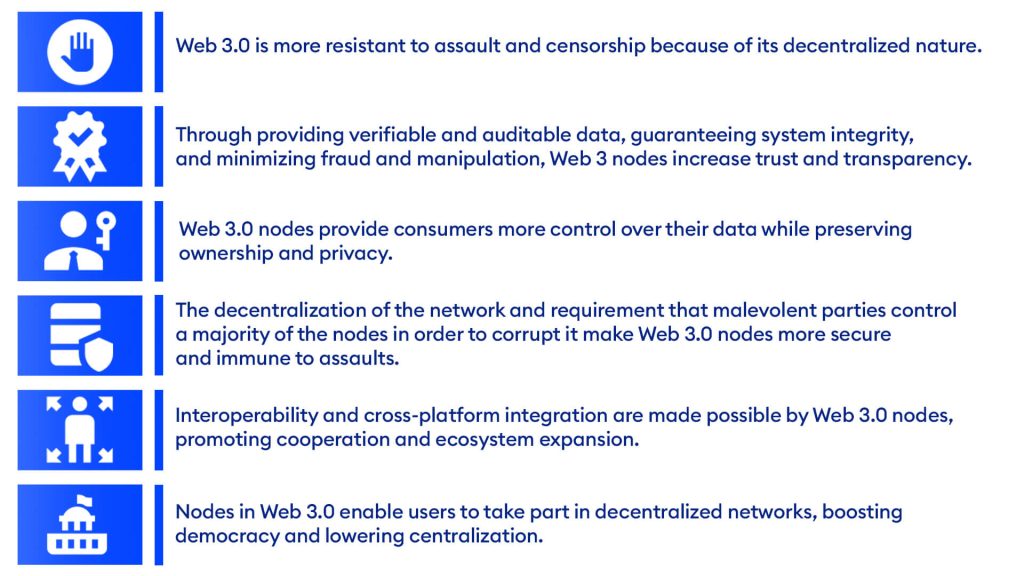
Web 3.0 nodes have a variety of functions that aid in the functioning and growth of decentralized networks. To begin with, nodes are critical in transaction validations, safeguarding the integrity of the decentralized system by validating transactions and preventing fraudulent operations. They also engage in the consensus mechanism, proposing, validating, or voting on new blocks to keep the blockchain in agreement on its current state.
In decentralized storage networks, nodes are involved in data storage and dissemination, offering storage capacity, redundancy, and data availability. They help network security by validating blocks, verifying transactions, and identifying and rejecting malicious activity. Nodes can also engage in network governance by voting, suggesting modifications, and engaging in decision-making procedures that influence the network’s rules and direction.
Furthermore, nodes in peer-to-peer networks can operate as content distribution sites, storing and serving material to enable efficient and decentralized content delivery. They can also help with interoperability and integration by allowing for the frictionless transfer of assets, data, or information between blockchain networks or between decentralized systems and the regular internet.
Another component of node functionality is incentive systems, in which nodes can engage in processes that reward network participants. Mining nodes in proof-of-work networks, for example, are rewarded for their computational effort, but master nodes or validator nodes may be rewarded for specific services or contributions to the network.
In Web 3.0, nodes do different jobs depending on the network or blockchain they’re in. They handle tasks like checking transactions, agreeing on rules, storing data, keeping things secure, managing how things work, sharing content, connecting different systems, and providing incentives. All of these tasks are crucial for making the decentralized web work.
Benefits of Web 3.0 Nodes
Web 3.0 nodes encompass a diverse array of advantages that play a pivotal role in driving forward the advancement and widespread acceptance of decentralized technologies. By leveraging the power of these nodes, the decentralized web ecosystem gains significant momentum and attains a multitude of benefits that propel it into the forefront of technological innovation.
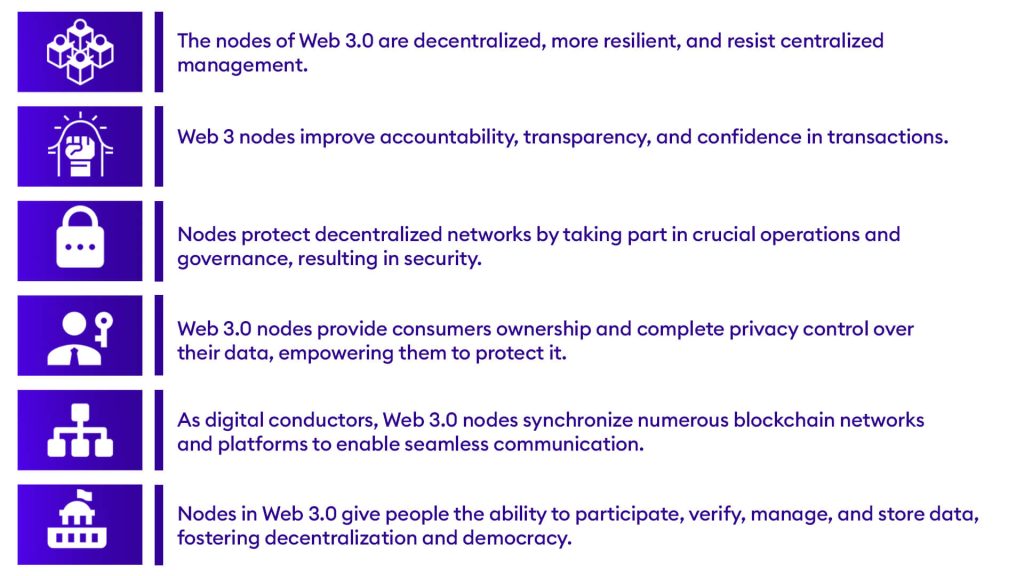
- Decentralization and Resilience: Web 3.0 nodes minimize dependency on centralized entities and improve network resilience and fault tolerance by spreading data, transactions, and functionality over a network of nodes. Because of this decentralization, Web 3.0 systems become more durable, resistant to censorship, and less prone to single points of failure.
- Trust and Transparency: These are enhanced through Web 3 nodes, which provide verifiable and auditable data. The integrity of the system is assured, and the danger of fraud or manipulation is decreased because transactions are checked and recorded by numerous nodes. The blockchain’s public ledger is accessible to anybody, encouraging openness and accountability.
- Security and Immunity to Attacks: Nodes are critical in safeguarding decentralized networks. They contribute to the system’s overall security by participating in transaction validation, consensus procedures, and network governance. Furthermore, because Web 3.0 nodes are decentralized, malicious parties would need to control a majority of nodes (51% in most cases) rather than a single central body to corrupt the network.
- Data Privacy and Ownership: Web 3.0 nodes provide consumers with more control over their data. Users can store their data among numerous nodes in decentralized storage networks, lowering the danger of data breaches or illegal access. Users maintain ownership of their data and can decide whether to give access to it or not, enhancing privacy and providing them more control over their personal information.
- Interoperability and Cross-Platform Integration: Web 3.0 nodes allow multiple blockchain networks and decentralized platforms to communicate with one another. They serve as bridges, transferring assets, data, or information seamlessly between protocols or platforms. This interoperability encourages cooperation, networking, and the growth of a single decentralized ecosystem.
- Empowering Network Participants: individual users are empowered to engage in decentralized networks thanks to Web 3.0 nodes actively. Anyone may run a node and help with data validation, governance, or storage. This inclusiveness promotes increased democracy and involvement in decision-making processes, hence minimizing the concentration of power in the hands of a few entities(centralization). 2
Challenges
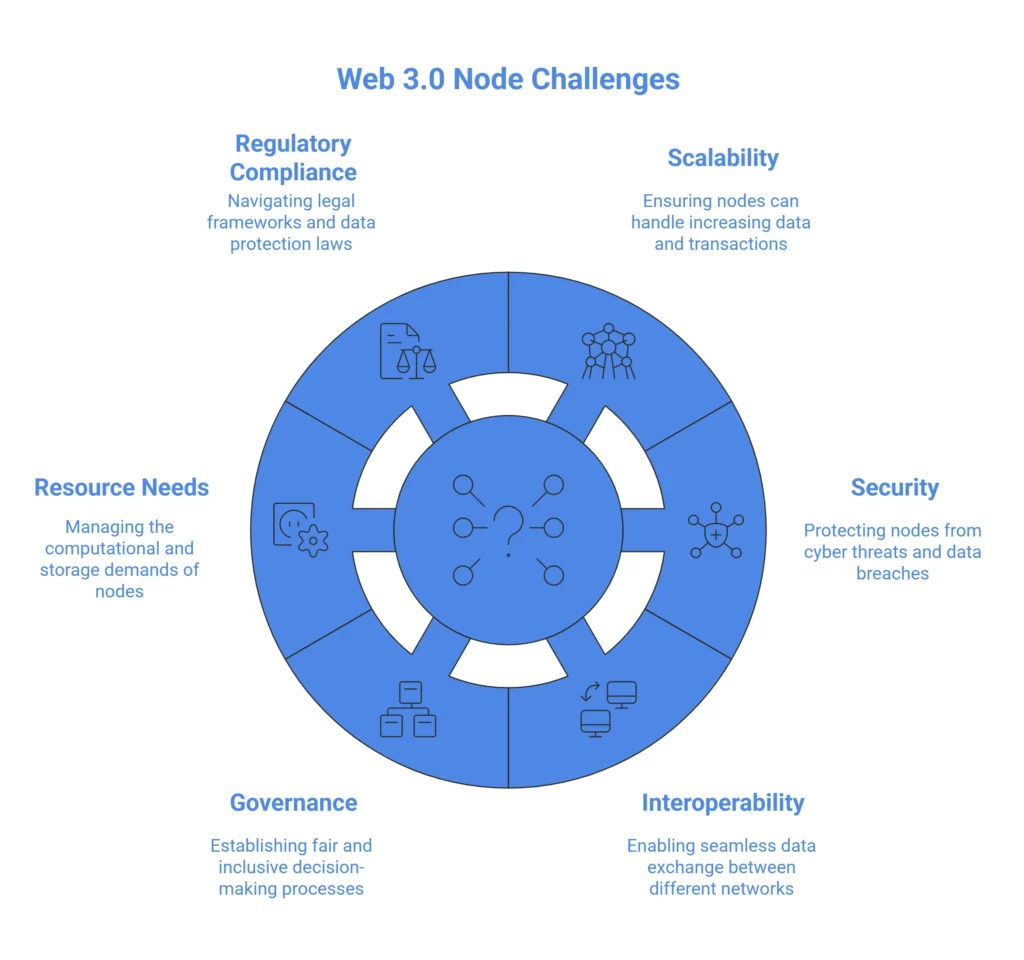
Implementing and managing Web 3.0 nodes is full of difficulties and issues. To begin with, scalability is a significant difficulty for Web 3.0 nodes. The sheer number of transactions and data might test the capacities of individual nodes as decentralized networks develop in size and popularity. In addition, maintaining network speed and preventing congestion requires effective scaling methods such as sharding or two-layer protocols.
Another difficulty is network security. While decentralization improves security, Web 3.0 nodes must still handle possible weaknesses and assaults. To protect against hacking attempts, malevolent parties, and potential exploits, node operators must install strong security measures. Furthermore, assuring the integrity and trustworthiness of information stored and delivered by nodes is crucial.
Interoperability is another important factor in Web 3.0 nodes. As decentralized networks expand, nodes’ capacity to connect and exchange data effectively across many protocols and platforms becomes increasingly important. Creating interoperability standards and protocols is critical for enabling the seamless movement of information and assets across multiple blockchain networks.
Another difficulty is node governance and decentralized decision-making procedures. Consensus on network upgrades, protocol modifications, and other governance choices gets increasingly difficult as the number of participants and nodes grows. It is vital for Web 3.0 nodes to design effective governance processes that assure inclusiveness, justice, and representation of varied stakeholders.
Furthermore, the resource needs for running nodes must be considered. Significant processing power, storage capacity, and bandwidth may be required depending on the type of node. These resource requirements may represent entrance obstacles for some participants, impeding decentralization efforts, and reducing Web 3 network accessibility.
Finally, regulatory constraints and legal framework compliance might pose difficulties for Web 3.0 nodes. Navigating regulatory frameworks, data protection regulations, and privacy rules becomes increasingly important when decentralized technology meets with existing legal institutions. Striking a balance between decentralization’s basic ideas and legal duties is an ongoing challenge for Web 3.0 nodes.
In constructing and administrating Web 3.0 nodes, addressing scalability, security, interoperability, governance, resource needs, and regulatory concerns are critical difficulties and considerations. Overcoming these obstacles is crucial to maintaining the decentralized web ecosystem’s long-term survival and success. 3
Node Future
The future outlook for Web 3.0 nodes is incredibly promising, with a transformative impact on the digital landscape. As decentralized technologies gain traction and mature, Web 3.0 nodes will continue to play a vital role in shaping the decentralized web ecosystem. Looking ahead, we can anticipate significant advancements in the scalability, security, and interoperability of nodes, enabling them to handle larger volumes of transactions and data while maintaining robustness and efficiency. This will contribute to a more seamless and user-friendly experience, empowering individuals to actively participate in decentralized networks.
Moreover, increased focus on governance participation will provide users with a voice in shaping the direction and rules of these networks, fostering a sense of ownership and community engagement. With ongoing innovation and collaboration, Web 3 nodes are poised to revolutionize how we interact with the Internet, ushering in a future where control, privacy, and trust are fundamental principles. The journey towards a decentralized and user-centric internet has begun, and Web 3 nodes are at the forefront, leading us into an era of unprecedented possibilities and opportunities.
- developers.Cloudflare: developers.cloudflare.com[↩]
- shiksha: www.shiksha.com[↩]
- techtarget: www.techtarget.com[↩]


